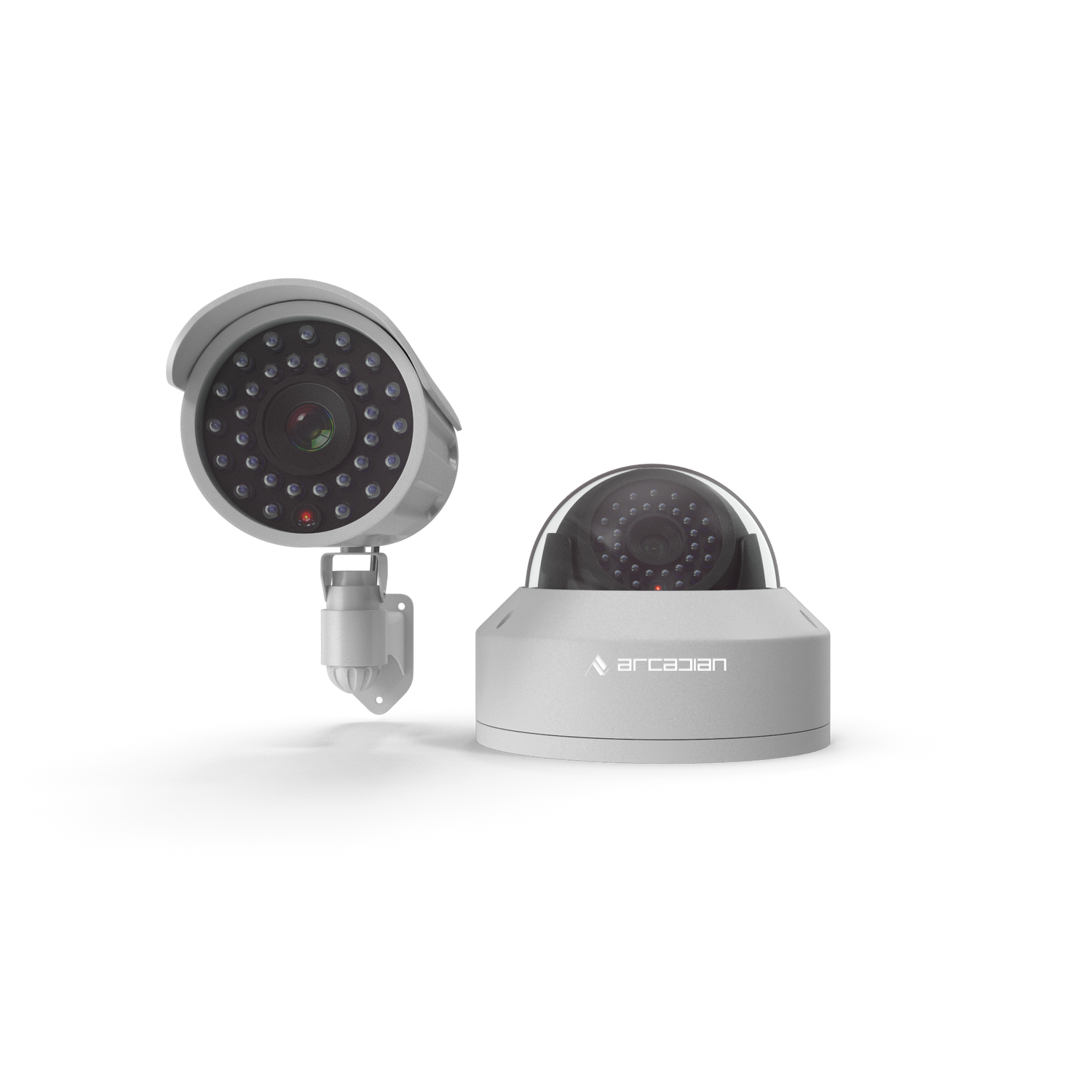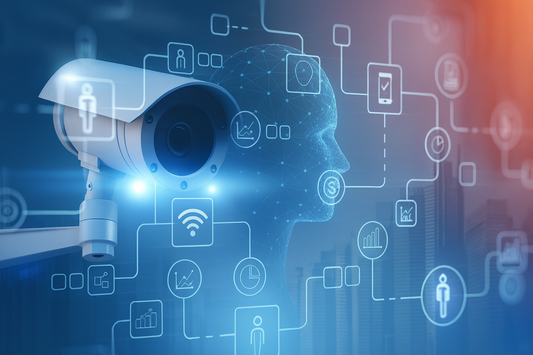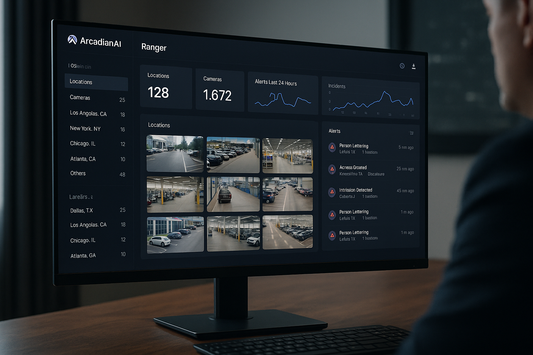The Evolution of CCTV: From Analog Cameras to AI-Powered Cloud Surveillance
From grainy analog CCTV footage to adaptive AI-driven cloud surveillance, the evolution of security cameras tells a story of progress, failure, and reinvention. Today, ArcadianAI represents the next chapter—turning video into intelligent, actionable data.

Introduction
In 1961, only 3% of U.S. businesses had CCTV cameras; today, that figure exceeds 85% (Statista, 2024). Yet despite this adoption curve, many organizations are still trapped in outdated systems: analog cameras, clunky DVRs, or even “cloud” platforms that do little more than replicate old models online.
This blog traces the history of CCTV—from its analog birth in the 1940s, to IP cameras in the 1990s, to the rise of VMS and VSaaS platforms in the 2000s, and now into the era of adaptive AI-powered surveillance. Along the way, we’ll expose how competitors like Verkada, Genetec, Milestone, and Eagle Eye Networks framed “progress,” and why most solutions still miss the mark.
ArcadianAI, with its intelligent assistant Ranger, represents the real next step: a platform that not only records but understands, adapts, and helps businesses make better decisions across security, operations, and compliance.
Quick Summary / Key Takeaways
-
CCTV has evolved from analog → IP → VMS → VSaaS → adaptive AI.
-
Legacy systems (NVR, DVR, static VMS) cause blind spots and inefficiency.
-
Cloud surveillance is growing 20%+ annually (MarketsandMarkets, 2024).
-
ArcadianAI transforms video into actionable, contextualized intelligence.
-
Ranger reduces false alarms and adapts to unique environments.
Background & Relevance
-
Global video surveillance market: $62 billion in 2023, projected to hit $95 billion by 2028 (Gartner, 2024).
-
Cloud-based VSaaS adoption is accelerating, with CAGR above 20%, driven by hybrid work, retail crime, and compliance demands (Forbes, 2024).
-
But crime rates and loss prevention costs continue to rise: U.S. retailers lost $121 billion to shrink in 2023 (NRF, 2024).
The conclusion? CCTV hardware alone is not enough. Surveillance must evolve to intelligence-first, adaptive platforms.
Core Topic Exploration
What Was Analog CCTV?
The history of CCTV began in the 1940s when Siemens engineers in Germany used cameras to monitor V-2 rocket launches. By the 1960s, banks, casinos, and government buildings had analog closed-circuit systems.
-
Strengths: Simple, closed loop, no internet dependency.
-
Weaknesses: Grainy footage, no remote access, VHS/DVR tapes, no search capabilities.
Analog was watch-only, not understand-only. Humans had to interpret every frame.
The IP Revolution: 1990s–2000s
By the mid-1990s, companies like Axis Communications launched IP cameras, bringing video into the digital age.
-
Strengths: Remote access, better resolution, scalable.
-
Weaknesses: Expensive bandwidth, reliance on NVRs, cybersecurity risks.
Competitors like Hanwha, Hikvision, Dahua flooded the market, driving prices down but also introducing supply chain security risks (NDAA bans in U.S. federal projects).
The VMS Era: Centralized Management
As IP cameras scaled, so did Video Management Systems (VMS) like Genetec Security Center, Milestone XProtect, and Avigilon Control Center.
-
Allowed centralized control of 100s–1000s of cameras.
-
Introduced integrations with access control and alarms.
-
Relied on heavy server infrastructure.
Problem: VMS was built for surveillance operators, not decision-makers. 99% of footage went unwatched.
VSaaS: Video Surveillance as a Service
By the 2010s, VSaaS providers like Verkada, Eagle Eye Networks, and Rhombus promised the cloud would solve everything.
-
Advantages: No heavy servers, remote access, recurring subscription model.
-
Flaws:
-
Still mostly static video storage, not contextual AI.
-
Limited customization—same “AI” across all customers.
-
Privacy controversies (e.g., Verkada camera breach, 2021).
-
The cloud made access easier, but not smarter.
The Rise of Adaptive AI in CCTV
2020s brought deep learning, but with it came confusion. Motion detection was rebranded as “AI.” Object classification was sold as intelligence.
But true adaptive AI security is different:
-
Learns behaviors unique to each environment.
-
Reduces false alarms by adapting to context.
-
Transforms footage into structured, searchable data.
This is where ArcadianAI and Ranger stand apart.
How ArcadianAI Redefines CCTV
-
Adaptive Intelligence: Ranger learns the difference between a delivery at 2 PM and loitering at 2 AM.
-
Cross-Sector Use: Retail, logistics, healthcare, education, and critical infrastructure.
-
Cloud-Native: No legacy NVR bloat—built for scale.
-
Actionable Alerts: Beyond video—business insights, compliance tracking, operational efficiencies.
-
Competitor Gap: Unlike Verkada or Eagle Eye, ArcadianAI doesn’t just store—it interprets and adapts.
Comparisons & Use Cases
ArcadianAI vs Legacy CCTV Systems
| Feature | Analog CCTV | VMS (Genetec/Milestone) | VSaaS (Verkada/Eagle Eye) | ArcadianAI Ranger |
|---|---|---|---|---|
| Video Quality | Low | High | High | High + adaptive AI |
| Storage | VHS/DVR | On-prem servers | Cloud storage | Cloud-native + AI |
| Intelligence | None | Limited analytics | Basic object detection | Adaptive contextual AI |
| False Alarms | Very high | High | Medium | Very low |
| ROI Beyond Security | None | Low | Moderate | High (ops + insights) |
| Compliance & Privacy | Minimal | Add-on | Questionable (breaches) | Built-in by design |
Real-World Applications
-
Retail: Ranger reduces shrink by detecting unusual patterns across multiple stores.
-
Logistics: Identifies inefficiencies in loading docks, not just intrusions.
-
Healthcare: Ensures compliance with restricted access zones.
-
Education: Helps detect loitering or after-hours trespassing.
-
Critical Infrastructure: Monitors anomalies in hazardous environments.
Common Questions (FAQ)
Q1: What is the history of CCTV?
CCTV started in the 1940s with analog closed-loop cameras, evolving into IP, VMS, VSaaS, and now adaptive AI surveillance.
Q2: How is CCTV different from cloud surveillance?
Traditional CCTV stores footage locally; cloud surveillance allows remote access and AI-driven insights.
Q3: What are the disadvantages of NVR/DVR systems?
They are static, require on-site hardware, and lack adaptability for dynamic threats.
Q4: Which competitors dominate the market today?
Verkada, Genetec, Milestone, Eagle Eye, and Avigilon are major players, but most lack adaptive AI.
Q5: Why is ArcadianAI different?
ArcadianAI turns footage into actionable intelligence, reduces false alarms, and adapts to each environment.
Conclusion & CTA
The evolution of CCTV tells a simple truth: recording alone is not enough. From analog to IP to VSaaS, every generation solved some pain points but created new ones.
ArcadianAI represents the real breakthrough—not just cameras or cloud, but adaptive AI intelligence that transforms surveillance into security, compliance, and business intelligence.
👉 See ArcadianAI in Action → Get Demo – ArcadianAI
Security Glossary (2025 Edition)
Adaptive AI Security — AI that learns and adapts to each unique environment, reducing false alarms and improving context.
Analog CCTV — Early closed-circuit television systems that recorded grainy footage to VHS/DVR.
ArcadianAI Ranger — Adaptive AI assistant turning video surveillance into actionable intelligence.
Cloud Surveillance — Video monitoring hosted in the cloud, accessible remotely with scalability.
DVR (Digital Video Recorder) — Device used in analog CCTV to store footage digitally.
Genetec Security Center — Leading VMS platform for enterprise surveillance management.
Milestone XProtect — Popular VMS software for multi-camera surveillance deployments.
NVR (Network Video Recorder) — Hardware appliance storing IP camera footage locally.
Object Detection — AI process identifying predefined objects like people or vehicles.
Shrink (Retail) — Loss from theft, fraud, or errors, often a driver of retail surveillance.
Static AI — Pre-trained algorithms applied universally without adaptation to local context.
Surveillance as a Service (VSaaS) — Subscription model for cloud-hosted video monitoring.
Verkada Cameras — U.S.-based VSaaS competitor, criticized for breaches and limited adaptability.
Video Management System (VMS) — Software used to manage multiple IP cameras and footage.
False Alarm Reduction — AI-driven filtering of irrelevant alerts to focus on real threats.
Critical Infrastructure Security — Surveillance solutions for power plants, utilities, and transport hubs.
Behavioral Analytics — AI identifying abnormal patterns of movement or activity.
IP Camera — Digital camera that streams video over a network, replacing analog CCTV.
Operational Insights — Business efficiency improvements gained from AI surveillance analysis.

Security is like insurance—until you need it, you don’t think about it.
But when something goes wrong? Break-ins, theft, liability claims—suddenly, it’s all you think about.
ArcadianAI upgrades your security to the AI era—no new hardware, no sky-high costs, just smart protection that works.
→ Stop security incidents before they happen
→ Cut security costs without cutting corners
→ Run your business without the worry
Because the best security isn’t reactive—it’s proactive.







